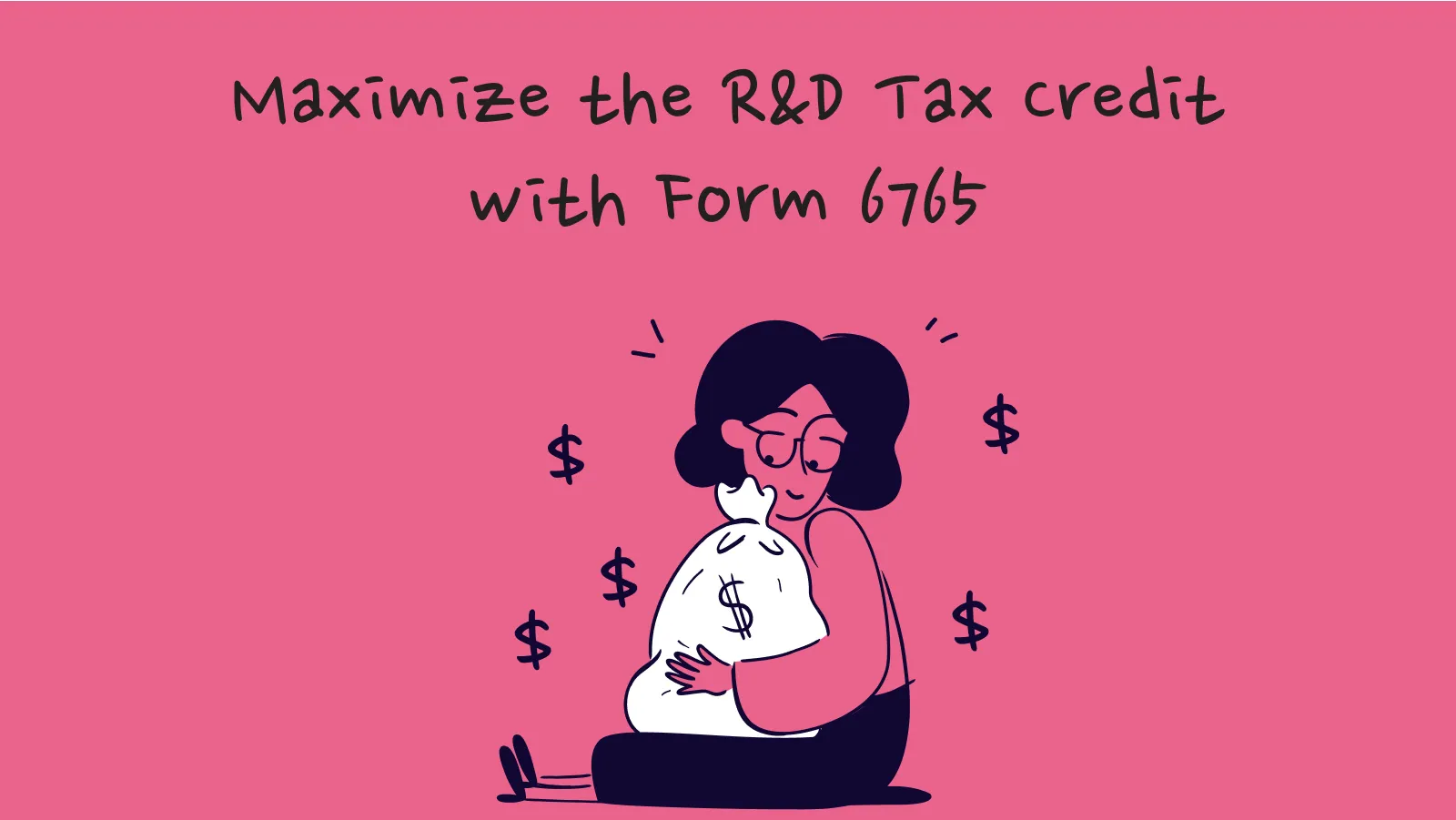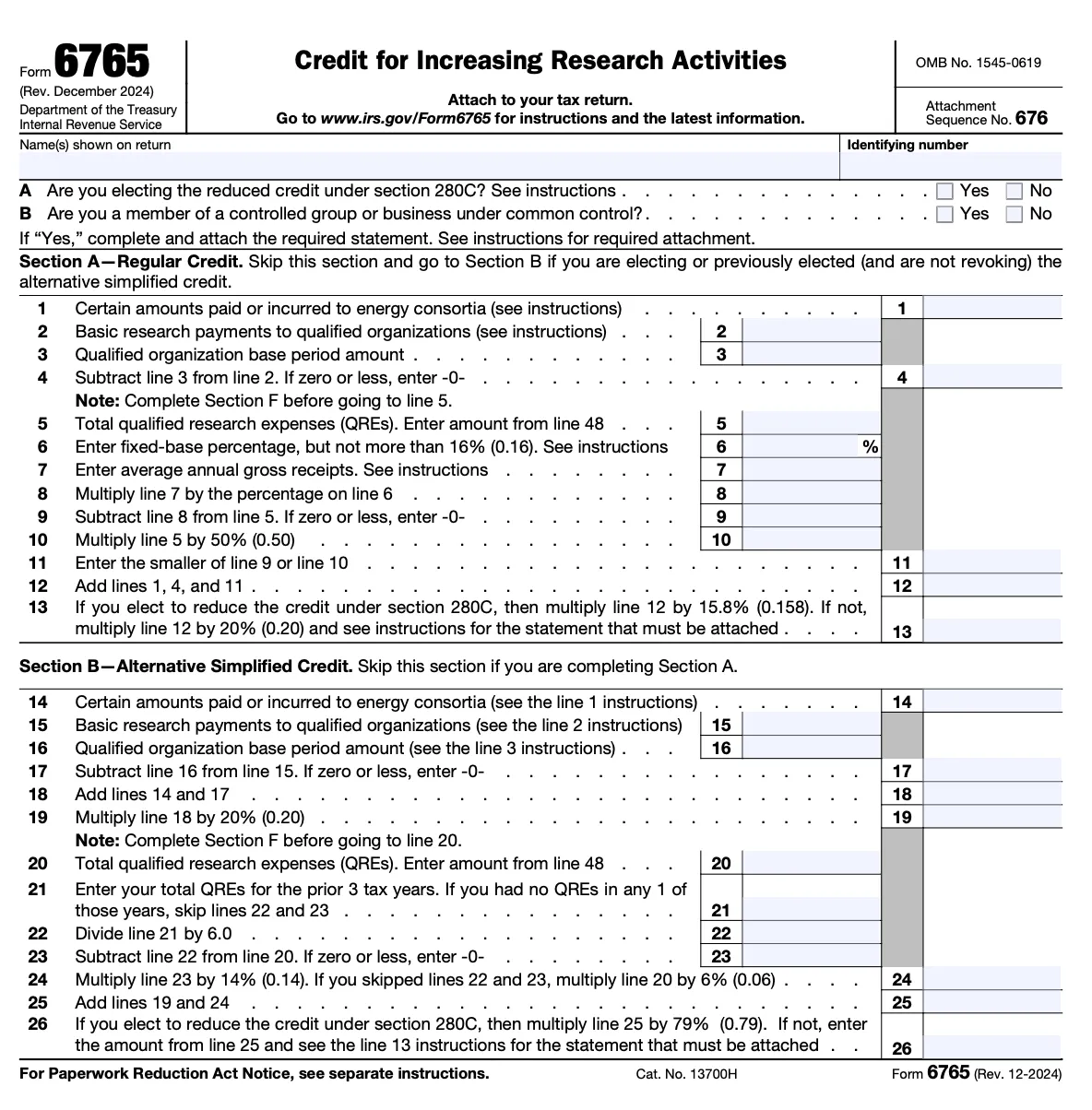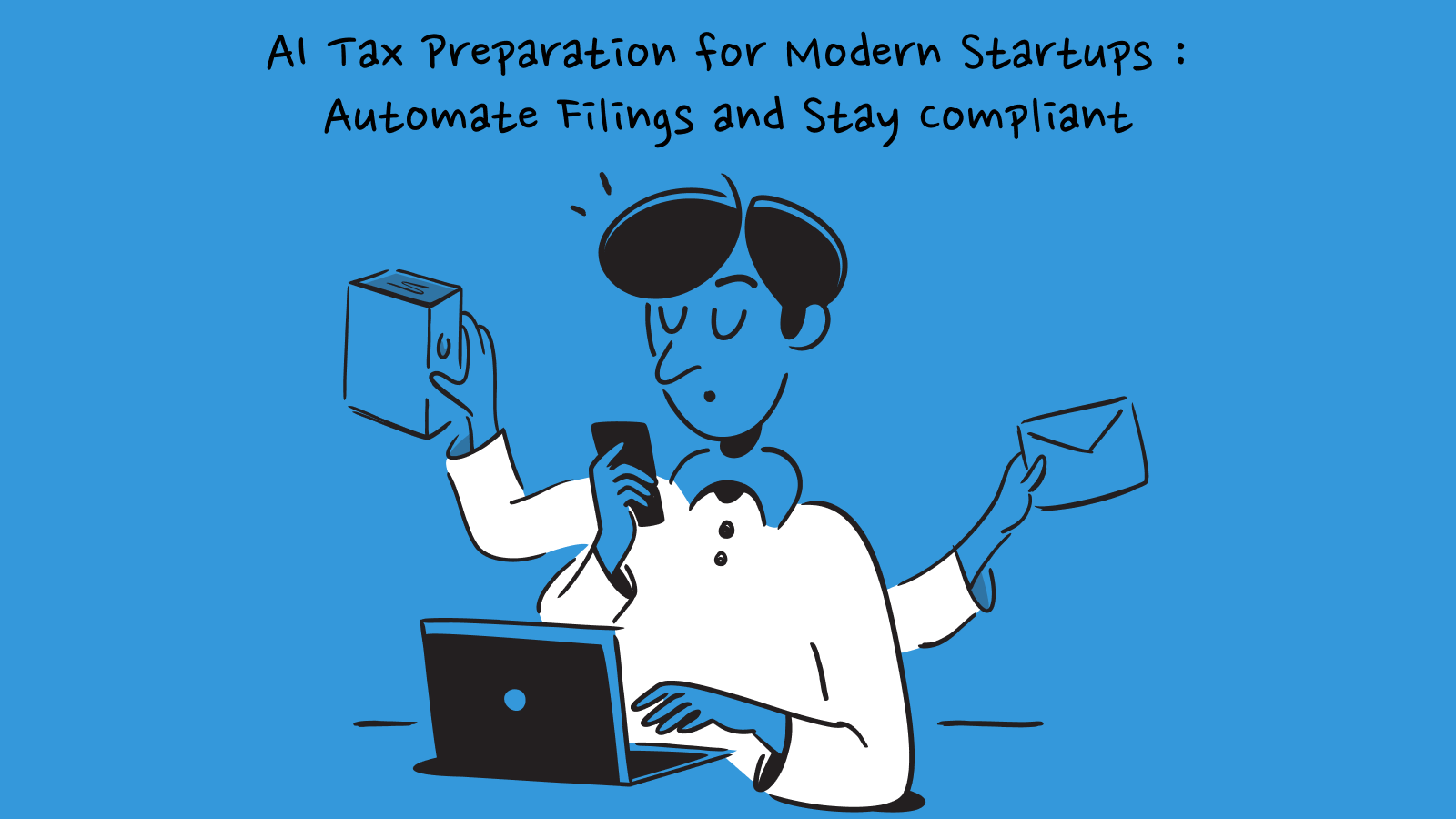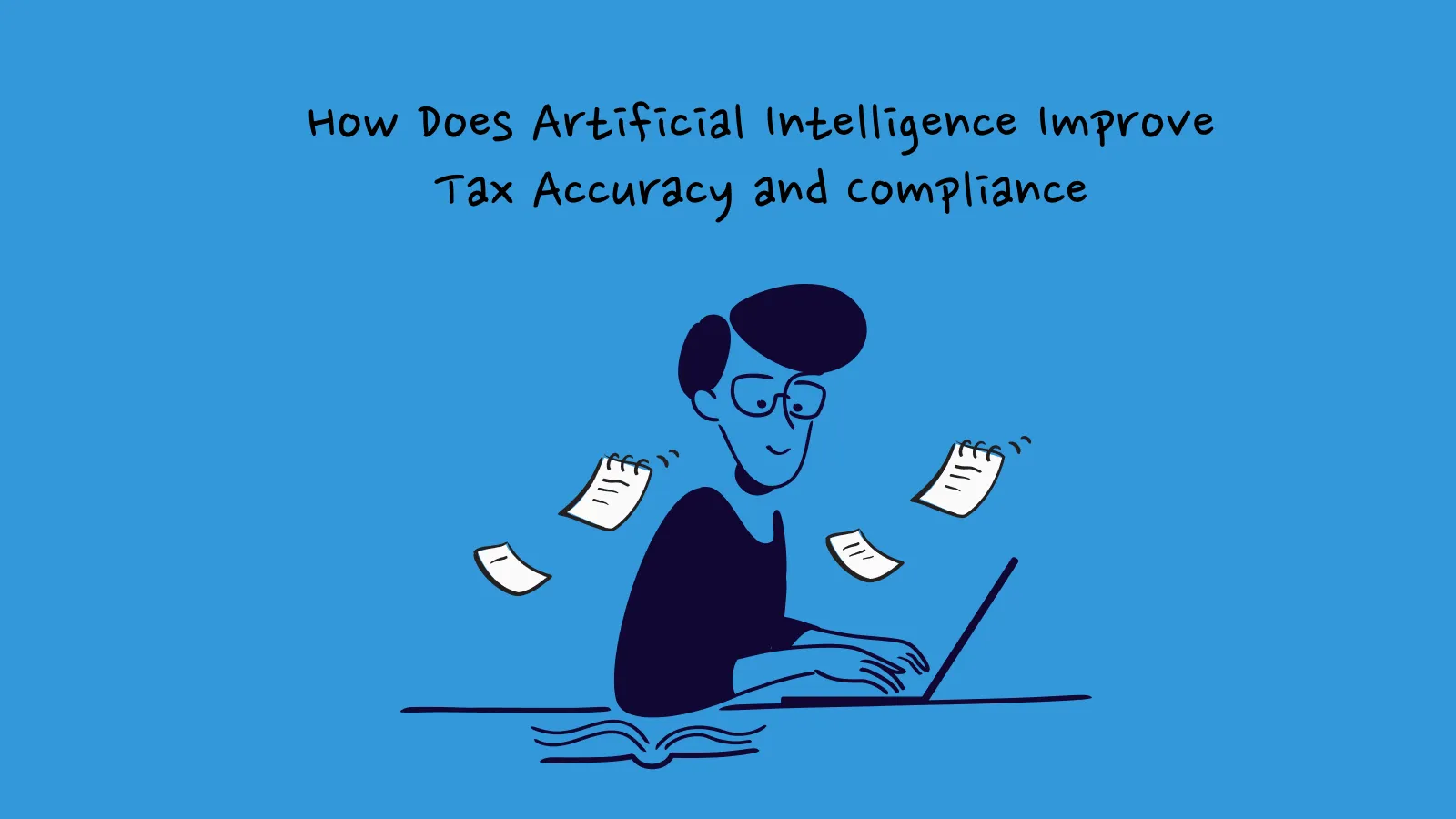Maximize the R&D Tax Credit with Form 6765

Innovation doesn’t just fuel growth, it can also reduce your tax bill.
If your startup is building new technologies, testing prototypes, or improving software, you may qualify for the federal Research & Development (R&D) tax credit, claimed using IRS Form 6765.
This guide explains how the credit works, who’s eligible, what expenses qualify, and what’s changed in the 2025 version of Form 6765. With the right documentation, your startup can offset income or payroll taxes, extend runway, and reinvest more into product development.
What Is IRS Form 6765?

Form 6765 is the official IRS document used to calculate and claim the federal R&D tax credit. It allows startups and other US businesses to report their Qualified Research Expenses (QREs) and determine how much credit they’re eligible for. The form includes multiple sections depending on which calculation method you use and whether you’re applying the credit to income taxes or payroll taxes.
It matters because this credit provides a dollar-for-dollar reduction in your tax liability, either on income tax or payroll tax, depending on your stage. For early-stage, pre-profit startups, it can be especially valuable for reducing employer payroll taxes and extending financial runway without raising funds.
Who Can Claim the R&D Tax Credit?
The R&D tax credit is available to any US business that performs qualified research activities, including early-stage and pre-revenue startups. If your startup is building new technology, improving existing products, or solving technical challenges, you may be eligible, even if you’re not profitable yet.
Startups with under $5 million in revenue and within five years of their first receipts can use the credit to offset up to $500,000 in employer payroll taxes annually, making it especially helpful during the early growth phase.
You may qualify if you...
- Develop software, internal tools, or platforms with a technical component
- Build, test, or refine physical or digital prototypes
- Employ engineers, scientists, or technical personnel for R&D
- Conduct systematic experimentation based in the US
- Are under $5M in revenue and within 5 years of your first gross receipts (for payroll tax offset)
What Expenses Qualify for the R&D Tax Credit?
To claim the R&D tax credit using Form 6765, your startup must identify and track Qualified Research Expenses (QREs). These are costs directly related to R&D activities that meet IRS criteria, typically involving a process of experimentation, technical uncertainty, and development within the US
Below are the main categories of QREs that most startups can claim:
1. Employee Wages
The largest component of most R&D credits comes from wages paid to technical employees. This includes engineers, developers, data scientists, and anyone directly involved in designing, testing, coding, or improving a product or process. You can also include supervisors and first-line managers if they’re directly overseeing R&D work.
Example: A full-time software engineer working on internal platform improvements qualifies. So does a lead developer managing a team building a new product feature.
2. Supply Costs
Materials used to develop physical prototypes or conduct experiments also qualify. This applies to tangible supplies consumed during the R&D process, but not to finished goods held for sale. These costs are most relevant for hardware startups or companies building physical products.
Example: Raw materials, 3D printing components, test batteries, or circuit boards used while prototyping a hardware device would be eligible.
3. Contract Research
If your startup outsources some of its technical work to third parties, those expenses may qualify though only 65% of the payment is typically eligible. The key requirement is that the contractor is doing US-based R&D on your behalf and you retain the rights to the results.
Example: Hiring a US-based machine learning consultant to build and train models for your product could count as qualified contract research.
4. Computer Leasing or Cloud Hosting Costs
Costs related to renting or leasing computer time for software development and testing are considered QREs. This often includes cloud services like AWS, GCP, or Azure when used to support technical experimentation, deployment, or load testing.
Example: If your team uses AWS environments to build and stress-test a new analytics engine, those hosting fees could qualify.
How to Maximize the Credit When Filing Form 6765?
Many startups underclaim simply because they don’t capture all eligible expenses, or they default to one credit calculation method without checking both. Form 6765 allows you to calculate the credit using the Regular Method (Section A) or the Alternative Simplified Credit (ASC) method (Section B).
Running both can help you choose the higher benefit.
Startups should also take advantage of the payroll tax offset in Section D if they meet the early-stage criteria, and be prepared for the newer qualitative documentation required in Sections E–G.
Here are best practices for startups to follow while filing for from 6765:-
- Calculate the credit under both the Regular and ASC methods to compare benefits before choosing.
- Track project-level costs, outcomes, and timelines to create a defensible audit trail.
- Use Section D to apply the credit against payroll taxes if you're under $5M in gross receipts and within five years of your first revenue.
- Complete Sections E–G thoroughly. These now require officer wages, project descriptions, and detailed summaries.
- Consult an R&D credit expert to review your methodology and documentation, especially if claiming a large credit.
- Link officer and employee wages clearly to specific R&D projects. This is one of the most scrutinized areas in audits.
What’s New in Form 6765 for 2024–2025?
Starting in tax year 2024 (filed in 2025), the IRS has introduced major changes to Form 6765 aimed at improving transparency and reducing abuse of the R&D credit. The most significant update: qualitative documentation is now required for most filers, not just large corporations. This means startups must describe their R&D activities in greater detail, not just report numbers.
New Sections E through G ask for project-level data, officer wage breakdowns, and categorized expense summaries. Even if your credit is modest, skipping these sections or providing vague answers could delay processing or invite scrutiny.
Key Changes to Form 6765 in 2025:-
Mistakes to Avoid while Claiming the R&D Credit
The R&D tax credit offers real financial benefits but only if filed correctly. Many startups lose out by misclassifying expenses, skipping required sections, or under-documenting their activities. With the IRS now requiring more detail, incomplete filings can delay refunds, trigger audits, or disqualify your claim altogether.
Here are some of the most common pitfalls to avoid:
Here are common errors to watch for:
- Failing to document how each expense links to an R&D project. Generic cost summaries are no longer enough, tie every QRE to a defined activity.
- Skipping Section G qualitative details. Even if you think you’re exempt, some situations (like amended returns) still require this section.
- Leaving out officer wages that were part of R&D oversight. Many founders wear multiple hats; don’t ignore their technical contributions.
- Missing the payroll tax offset. Early-stage startups often forget to check Section D, even when they’re eligible to claim up to $500K.
- Not accounting for acquisitions. Failing to adjust your base year or disclosing a recent acquisition can invalidate your credit calculation.
How Inkle Supports Form 6765 Compliance and R&D Credit Optimization
Filing Form 6765 is about backing every claim with the right documentation, calculations, and context. Inkle helps startups stay fully compliant while maximizing the R&D credit, especially those operating across India and the US or working with lean finance teams.
With automation and expert guidance, Inkle streamlines QRE tracking, credit calculation, and audit-ready documentation helping you avoid costly mistakes and capture every dollar you’re eligible for.
With Inkle, you can:
- Identify eligible R&D activities and accurately track qualified research expenses (QREs)
- Calculate your credit using both Regular and ASC methods to find the best outcome
- Prepare complete and compliant Form 6765 filings, including new Sections A–G
- Apply for the payroll tax offset if you're an early-stage startup
- Stay current on IRS rule changes and thresholds to avoid penalties or delays
Book a demo with Inkle to simplify Form 6765 filing and maximize your credit.
Frequently Asked Questions
What is IRS Form 6765 used for?
Form 6765 is used to calculate and claim the federal R&D tax credit. It reports your qualified research expenses (QREs) and determines how much tax credit your business can apply against income or payroll tax.
Can early-stage startups benefit from the R&D credit?
Yes. If your startup has less than $5 million in gross receipts and is within five years of its first revenue, you may apply the credit against up to $500,000 in employer payroll taxes annually.
What types of expenses count as qualified R&D costs?
Eligible expenses include wages paid to technical employees, supplies used in prototyping, payments to US-based research contractors, and cloud computing costs tied to development or testing.
What’s new in Form 6765 for 2025?
New Sections E–G now require detailed disclosures about officer involvement, project descriptions, and categorized QREs. These updates apply to most filers and are mandatory for large credit claims.
Do I have to file Section G if I’m a small startup?
Generally, no. If your QREs are under $1.5 million and your gross receipts are under $50 million, you’re exempt unless filing an amended return. But always confirm based on your situation.
How does Inkle help with Form 6765?
Inkle helps startups track R&D activity, calculate credits under both IRS methods, prepare audit-ready documentation, and file Form 6765 with full compliance.




